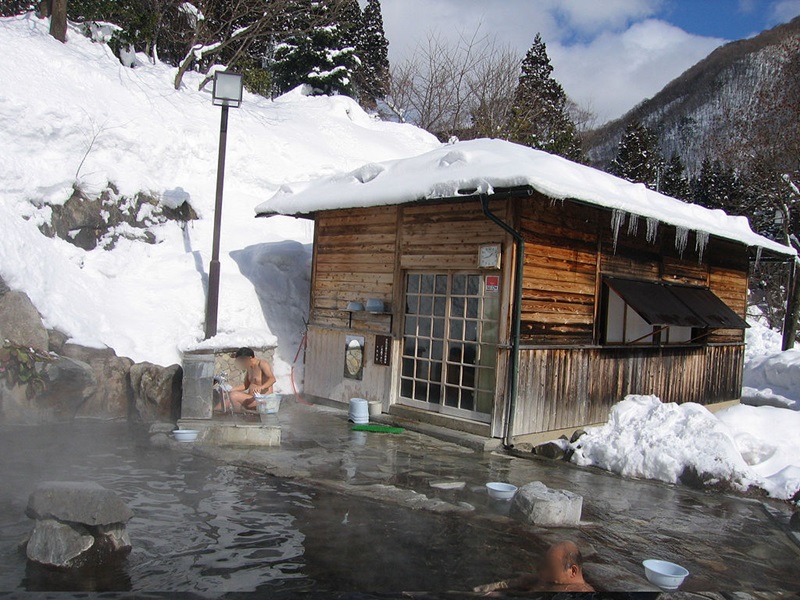Onsen: Japanese hot springs
The ‘Onsen (温泉)’ are the Japanese equivalent of our hot springs. Japan is a country with high seismic and volcanic activity, which has led to the formation of many thermal (hot) water springs; there are more than 27,000 of them according to information updated in March 2019.
Today, in total, there are more than 2,000 Onsen throughout Japan, in all the prefectures of Japan; there are various archaeological sites and artefacts, with which a certain period can be determined, from which the Japanese began a close relationship with the Onsen. According to an older hypothesis, this relationship began 6000 years ago, in the Jōmon period (10000 B.C. to 300 A.D.).
In Japan, from ancient times, ‘bathing’ was considered as ‘cleansing both the body and the heart’: Japanese monks often did/do an ancient practice of Shintoism, called ‘Misogi (禊ぎ)’, to purify themselves of sins, bad luck and defilements under the waterfall or by the river.
Later, however, in the middle of the 8th century, an important teaching arrived in the country: ‘bathing with hot water or entering the onsen gives merits’, being able to remove 7 diseases and obtain 7 fortunes. In fact, onsen can have certain healing effects for illnesses and injuries.
Since onsen are considered places of ‘relaxation’, it is usually recommended to speak softly and not make any disturbing noises; their main effect is ‘stimulation’.
In fact, various mineral salts from the onsen enter the body to promote hormonal secretions, and the sympathetic and parasympathetic nervous systems gradually try to balance each other by making the body relax.
The most popular places are ‘Beppu (別府)’. , “Hakone (箱根)”, “Kusatsu (草津)” and “Hokkaidō (北海道)”, but many spas can also be found in other areas.
Onsen can be indoor , ‘Uchiyu (内湯)’, or outdoor , ‘Rotenburo (露天風呂)’, and are usually found in 2 places:
– ‘Ryokan (旅館)’, inns where you can sleep in a bookable room and where you can have lunch or dinner. Usually in Ryokan you can reserve a bathroom in the room to enter as a couple.
– Public ones run by the municipality, called ‘Sentō (銭湯)’, are places set aside for washing and enjoying a bath. Like ryokan, most of them are chargeable but free ones can also be found. In most onsen, bathrooms are generally separate for males and females, like the Ryokan.

How to behave in the onsen
Before entering the hot-water baths, it is mandatory to wash and rinse thoroughly. Before the tubs there are taps with small stools and basins with which you can wash yourself. It is rude to enter the water still soapy or dirty for 2 reasons:
– it is a communal room but you do this at home too: before entering the tub, you clean yourself.
– to avoid excessive body temperature fluctuations as the water is hot.
In traditional onsen it is forbidden to use a swimming costume as it could be soiled with dust or detergent residue. However, in modern onsen, which are more like water parks, wearing a swimming costume is allowed.
You usually carry a small towel with you, but this must be left out of the water or in the drawers where you leave your clothes.
It is advisable to speak softly and not make loud noises, because onsen are considered places to relax.
By the way, in many places it is forbidden to enter if you have tattoos, because in Japan tattooed people are associated with the Yakuza ‘ヤクザ’ (mafia). In some particular onsen they are tolerated, but if you have one, it is always best to ask before entering.
How to get organised if you have tattoos
If you have not very big tattoos and you still want to experience the onsen, you could try covering them with special patches or with special foundation used especially in theatres by actors.
From my own experience, since I did not want to preclude myself from this experience and since I also had to use the public toilets, which are also precluded to tattooed people, with the fear that the foundation would dirty the water or in any case melt, I equipped myself with “tattoo cover” patches.
Finding them was not easy and in the end I bought them from the English site Hide Ink, where I bought a pack containing 8 patches.
The patches are about 8.5 cm x 13 cm and work like the temporary tattoos we used to get when we were kids: you apply the patch to the skin, wet it with a damp cloth and remove the plastic part: the coloured part will remain attached to the skin. Thanks to this feature, it is possible to join several pieces together or layer these patches.
From my personal experience I can say first of all that I got the wrong colour! I in fact bought the Ivory colour, the lightest available, with the result of having an almost white square on my pinkish skin, but still better than tattooing (or at least that’s how it is in the Japanese mentality).
Moreover, I had to put on three layers because, as the area where I have the tattoo is quite ‘mobile’, the adhesive layer on the skin always tended to crack (but not to peel off) covering the writing a bit badly.
The first few hours that you ‘wear’ this transfer is a bit annoying, after which it will adapt to your skin and you won’t feel it anymore.
It lasts so long that the worst thing is to take it off: cotton wool, a lot of oil and a lot of patience. If you use it, put it on when you need it and take it off at the end of the holiday, as it resists water easily.
In conclusion
For the Japanese, the onsen are not just a place to wash: for them it has always been a part of their culture to ‘cleanse the heart too’ and the onsen
offer many positive effects both physically and mentally.
By the way, there are the comic Japanese films, ‘Thermae Romae I and II (テルマエ・ロマエ)’, which deal with the modern Japanese onsen in which the protagonist, Lucius Quintus Modestus (100 BC -??), learns many aspects of the Japanese way of life in order to create his own baths in Ancient Rome. The protagonist’s existence is fictional, however, some major figures of the time are introduced. By also watching these films, you may discover the Japanese cultural aspects in this regard!
Perhaps the culture seems complicated to you because of the rules to be followed, but rest assured: if you are not sure, if you are doing the right thing, try to imitate the other guests!
Author (tattoo section)
Silvia Zampieri
Revised by:
Chinami Matsushima


